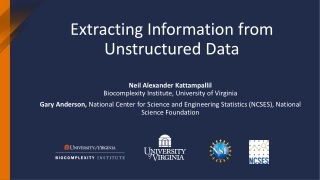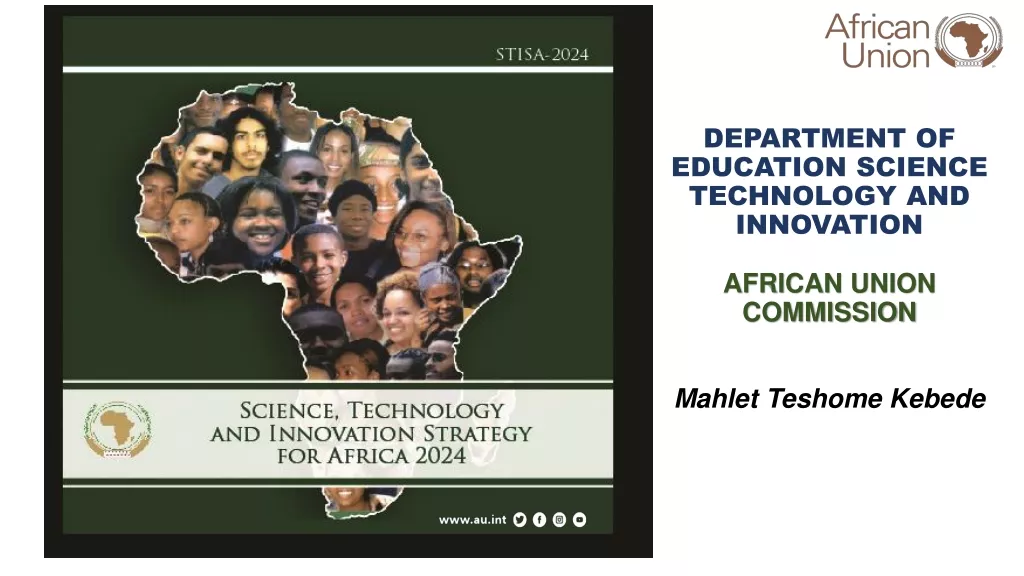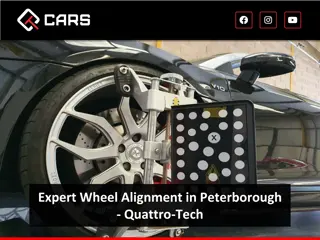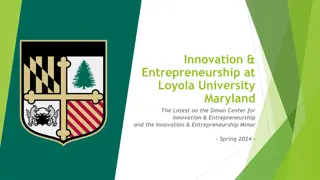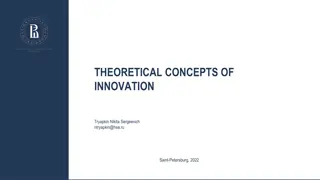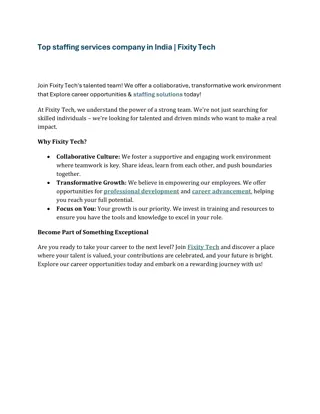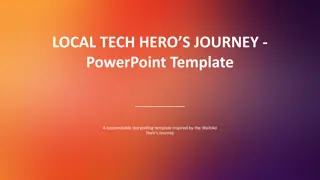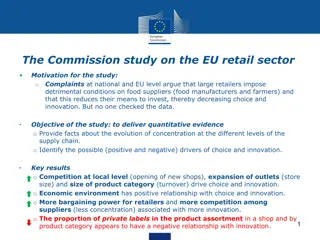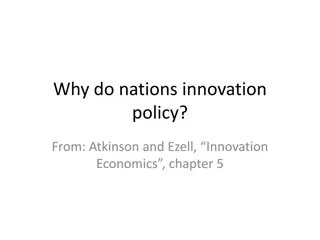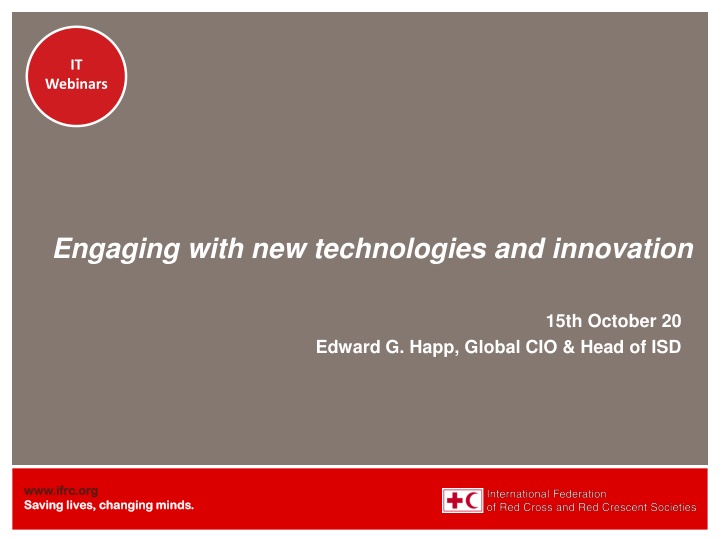
Embracing New Technologies in Humanitarian Action
Explore the challenges and opportunities of rapidly evolving technologies in the humanitarian sector, focusing on bridging the digital divide and ensuring principled technology use for the benefit of vulnerable communities. The webinars delve into themes such as engaging with innovation, strategic contexts, and the impact of technology on humanitarian initiatives, advocating for ethical and efficient utilization of technology to enhance humanitarian efforts worldwide.
Download Presentation

Please find below an Image/Link to download the presentation.
The content on the website is provided AS IS for your information and personal use only. It may not be sold, licensed, or shared on other websites without obtaining consent from the author. If you encounter any issues during the download, it is possible that the publisher has removed the file from their server.
You are allowed to download the files provided on this website for personal or commercial use, subject to the condition that they are used lawfully. All files are the property of their respective owners.
The content on the website is provided AS IS for your information and personal use only. It may not be sold, licensed, or shared on other websites without obtaining consent from the author.
E N D
Presentation Transcript
IT IT Webinars Webinars Engaging with new technologies and innovation 15th October 20 Edward G. Happ, Global CIO & Head of ISD www.ifrc.org www.ifrc.org Saving lives, changing minds. Saving lives, changing minds.
Thesis IT Webinars New technologies are developing faster than we can keep up with them. And the barriers to entry are low to non-existent for the average person to build a collection of personal tools and applications. Teams take their own technology initiative and so- called shadow IT mushrooms. At the same time, organizations continue to grow and mature, especially in new economies, with their technology portfolios to run the business getting ever more complex and data more intertwined. What s an IT leader to do? We will explore these two threads of growth and the paradox of embracing them. www.ifrc.org www.ifrc.org Saving lives, changing minds. Saving lives, changing minds.
Three themes for technology, innovation and humanitarian action IT Webinars www.ifrc.org www.ifrc.org Saving lives, changing minds. Saving lives, changing minds.
Bridging the Digital Divide Webinars Technology and our Vision IT New technology is an opportunity to do more and reach further, key aim of Strategy 2020. Allows us to work more efficiently and productively. Can provide means of communicating more directly with vulnerable people. Means to engage and mobilize Youth and Volunteers. Can lead to more ecologically sensitive, greener organization. Technology is also a risk that we must recognize and advocate for the protection of vulnerable people. Technology is unevenly distributed in world and risks exacerbating divide between richer & poor communities. We have a moral obligation to Bridge the Digital Divide. Technology can also put people at risk when their information is not protected. When used in unprincipled ways, it can also dehumanize fundamental human connections. Can also disrupt humanitarian work when systems on which we depend fail.
Bridging the Digital Divide Webinars Technology and our Vision (cont.) IT Technology in humanitarian action and vulnerable communities must be principled technology. Essential that we continue to be guided by the fundamental principles as we apply technology. Principles make effective humanitarian action possible in challenging situations. We are in the unique position to advocate and ensure humanitarian principles are part of the agenda to bring technologies to all people in the world.
Bridging the Digital Divide Webinars IT Strategy Context IT Get in Increasing Impact for Beneficiaries Competitive or Leading BENEFICIARY Differentiating Increasing Impact for Beneficiaries Beneficiary & Field Facing PROGRAM Move up Improving Program Delivery OPERATIONAL Efficient Helping the Organization Run Donor & HQ Facing FOUNDATIONAL Keeping the Lights On Get out
Bridging the Digital Divide Webinars IT
Bridging the Digital Divide Webinars Innovation at the margins IT Historical IT all components provided Local innovation is more likely and sustainable at the outer layers of IT delivery User Devices User apps Current Era Users bring their own devices and apps Network Future Era Users bring their own networks Enterprise apps Standard core it is unlikely users will have or should have their own Finance, HR, Supply Chain, and Legal applications and data Data External crowd-sourced data is pushing the internal data paradigm
Shadow IT IT Webinars Shadow IT can be described as the IT work done outside the IT department s budget and knowledge. Represents an estimated 23% of the IT application work done at IFRC at an estimated cost of over 600,000 CHF per year and growing There are over 35 innovation initiatives happening across the IFRC locations www.ifrc.org www.ifrc.org Saving lives, changing minds. Saving lives, changing minds.
Yin and Yang of Shadow IT IT Webinars On the one hand Shadow IT is considered by many an important source for innovation and such systems may turn out to be prototypes for future approved IT solutions and 1. On the other hand Shadow IT is a risk ... Shadow IT solutions are not often in line with the organization's requirements for control, documentation, security, reliability, etc. 2. www.ifrc.org www.ifrc.org Saving lives, changing minds. Saving lives, changing minds.
Bridging the Digital Divide Webinars Three Types of Innovation* IT Empowering (or disruptive) innovation transmutes complicated and costly products available to a few into simpler, cheaper products accessible to many creating new markets and wreaking havoc within industries (e.g., Ford Model T car) Sustaining innovation replaces old models with new products that often incorporate new technology and novel design features. making things incrementally bigger, more powerful, and more efficient (ex. Toyota Prius) Efficiency innovation makes existing products more proficiently (ex. Lean production) Only disruptive innovations create new jobs *Clay Christensen, Davos interview, January 2013
Bridging the Digital Divide Webinars What are we trying to optimize? IT 1. Thinking outside the box; engage the creativity of our people 2. Investing small amounts for big returns 3. Delivering new program/services that demonstrate impact and scale In short, engaging our creativity to maximize supply and minimize constraints
Bridging the Digital Divide Webinars Models of Innovation IT Traditional, top-down innovation Discovery innovation, an inverted model Disruptive Innovation, Clay Christensen model The R&D lab, corporate model Controlled experiments, the Dartmouth model Crowdsource ideagoria, the Tapscott model 1. 2. 3. 4. 5. 6.
Application Catalog of Standards & Choices Bridging the Digital Divide Webinars IT Discover Harvest NS IT Survey - Applications Scale up Application Portfolio Review Application Catalogue Criteria 900+ De facto vendor standards Application Contest Application Catalogue is the window for NSs into supported applications 16
Bridging the Digital Divide Webinars Recommendation IT Combining the Discover and Harvest model (option 2) with Controlled Experiments (option 5) may be best suited for a nonprofit organization budget and culture Use a project review panel, pilots and contests to create an ecosystem for innovation to take root, flourish and scale Disciplined experimenting to take projects to Pilot -> Scale -> Mainstream, with try-learn-do investment levels Create an innovation fund to get started Allocate an initial budget of 1.5M CHF and evaluate after one year (See the IT Think paper for details)
A Project Review Panel for Continuous Innovation Harvesting Bridging the Digital Divide Webinars IT Many Ideas A Few Successful Mainstream Programs 20 Small Pilots (20K each) 5 Scale up (100K each) 2 Mainstream (300K each) 6 month s 24 month s 36 month s
Bridging the Digital Divide Webinars ISD Management Risks IT Risk # Risk Description Key Mitigation Points Continued membership in leading edge organizations like NetHope, ICSC and university research. Create a discretionary innovation fund to encourage leading-edge projects. 77 Disruptive innovations in technology cause IFRC to fall further behind competitors. Includes digital program development (ICT4D), direct connections with beneficiaries, and digital fundraising direct to local NGOs. Needs to be part of Chart of Accounts reform (Angela Eaton working on this). 76 Lack of insight into IT spending across all offices and grants means inability to identify redundancies in IT costs and track Shadow IT. Procurement and inventory should be under Unrestricted budget. Allocate part of the project budget to finalize phase 1 of the project. 74 Cancelation of the DMDS project due to funding issues will impact how IFRC does business. HLS and Logic are very old systems, procurement not standardized across departments and zones. Management continues to triage the non-IT funded projects. Test case proposal to charge back PM efforts to department (e.g. Health). 73 Management time required for restricted projects limits capacity (DMDS, Post2015 MDG). Allocate more budget to the DD initiative (e.g DFID), fund Tech Advisory Unit, and need to maintain DD as an RM priority. 72 Risk of lack of RM fundraising puts projects in jeopardy (DMDS, Digital Divide). Some projects have been put on hold per Finance. Studying impact and plan to meet with finance to discuss financial impact of projects (maintenance, depreciation) and how to absorb the increase. 71 Risk of not being able to sustain increase in annual maintenance due to cloud pay-per-use model & portfolio growth, which differs from the traditional model of buying software. Delays in projects have been addressed with project management. Now need to reconsider increasing project and core budget to solve growing project demand & innovation needs. 62 Growth in project portfolio continuing
Defined classification of Information to understand security impact Bridging the Digital Divide Webinars IT Information category & non-exhaustive list of examples Estimated % of information Operational impact and financial loss of the unauthorized disclosure, alteration, or destruction of information Highly restricted . Examples: Vulnerable populations highly sensitive data with individual names; Sensitive disciplinary process information; Fraud/corruption investigations; Highly confidential audit reports Between 1-2% Severe Restricted. Examples: Personally Identifiable Information (PII) on staff or beneficiaries (e.g. name, passport number) Beneficiary data with individual names Personnel files and work history data Between 3-4% Significant Internal (default category until information is classified). Examples: Beneficiary data without individual names; Internal communications Internal policies, procedures and standards Limited or none Up to 95% Public (deliberately made public). Examples: External press releases and publications; Financial statements after release; Appeal documents None expected
Bridging the Digital Divide Webinars Some questions for local applications IT How do we move local applications to regional & global stage? How is it sustainable? Is funding is in place to scale and survive developer and sponsor turnover. How is it maintainable? Does it have technology architecture, standards, integration to work in IFRC IT ecosystem? How is it supportable? Is the training and service plan to support users in place before growing the base of users? 1. 2. 3. The Global/NS potential and sharing needs to be built into the design from the beginning, not at the end of a project Also time and costs for applications need to be locally affordable, not centrally, consistent with NS capacity building model.
IT In Short Webinars We need to use Federation resources effectively and that includes technology and ISD ISD s responsibility is to deliver IT value to the whole secretariat and beyond (convening the RCRC IT market of sharing) Zones can contribute to this by developing local applications in such a way that we can use them more widely And avoid divergence by developing applications in isolation Avoiding applications that duplicate, undermine or complicate work which is being carried out elsewhere Championing data standards for consistency This takes consultation www.ifrc.org www.ifrc.org Saving lives, changing minds. Saving lives, changing minds.
What to do to turn Shadow IT into Impact IT? IT Webinars Consult with IT Department (ISD) We want to build bridges, not obstacles Consult with ITSG (the IFRC IT governance arm) For projects over 50K, see the TOR Use the IT Project Methodology developed with Accenture Route consulting projects with IT components to ISD for review (an HR, Legal ask) Use the Technology Catalogue (who has already done something like I want to do?) Use commercial off-the-shelf (COTS) solutions Avoid large custom projects with high TCO 1. 2. 3. 4. 5. 6. www.ifrc.org www.ifrc.org Saving lives, changing minds. Saving lives, changing minds.
IT How do we motivate sharing ideas with ISD? Webinars Where is the magnet for innovation? o The Technology Catalogue: recognizing pride in authorship How to we keep this positive and fun? o The applications contest How do we better understand the risks? o Continue to develop the case studies o Educate staff on the checklist ISD needs to be a trusted advisor and ISD needs to protect the organization www.ifrc.org www.ifrc.org Saving lives, changing minds. Saving lives, changing minds.
Bridging the Digital Divide Webinars ISD in Balance IT The Future-Strategic The Present-Operational
IT Webinars Questions? www.ifrc.org www.ifrc.org Saving lives, changing minds. Saving lives, changing minds.
FOR FURTHER INFORMATION ON THE DIGITAL DIVIDE INITIATIVE, PLEASE CONTACT: IFRC INFORMATION SERVICESDEPARTMENT ED HAPP, HEAD OF ISD & GLOBAL CIO TEL. : +41 022 730 4365 EMAIL: edward.happ@ifrc.org THIS PRESENTATION IS PUBLISHED BY INTERNATIONAL FEDERATION OF RED CROSS AND RED CRESCENT SOCIETIES P.O. BOX 372 CH-1211 GENEVA 19 SWITZERLAND TEL.: +41 22 730 42 22 FAX.: +41 22 733 03 95



